
Osteochondrosis occurs as a result of uneven load on the spine. Provoking factors:
- heavy physical activity;
- wearing the wrong shoes;
- malnutrition;
- problems with metabolic processes;
- nervous and emotional exhaustion.
The disease can occur during pregnancy. Greater risk in multiple pregnancies. The pathological process may be genetically determined.
Stages of development and photos
The development of osteochondrosis occurs slowly.There are 4 main stages of the disease:
- First stage. The patient feels discomfort when walking for a long time and staying in one position. Seals begin to form in the spinal discs.
- Second stage. Painful sensations occur. The doctor prescribes manual therapy and painkillers.
- Third stage. There are pronounced degenerative changes in the intervertebral discs.
- Fourth stage. The final stage of the development of the disease, in which almost all parts of the spine are affected.
At the last stage, conservative therapy will be ineffective. The doctor prescribes surgery, which will require a long recovery.
In the photo you can see how the disease manifests itself at different stages of the disease.
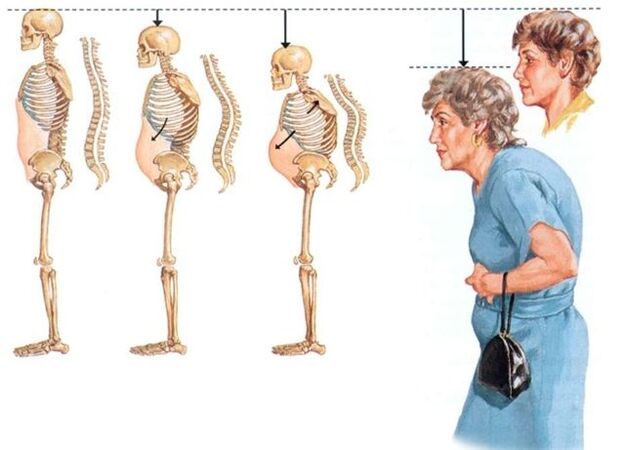
General symptoms
Osteochondrosis can affect one or more parts of the spine. The vertebrae of the cervical spine are most often affected. The clinical symptoms of such a deviation are directly related to the functioning of the brain. Let's consider all the main symptoms of this disease.
We invite you to watch a video about the symptoms of osteochondrosis:
Pain in the back of the head, neck and collar area
Patients often experience pain in the neck, occipital and collar areas. This occurs as a result of insufficient blood supply to parts of the brain.Deformation of the vertebrae leads to compression of the vertebral artery. Against the background of such degenerative processes, a hernia may occur.
Along with pain comes the risk of serious complications. For example, blood pressure abnormalities or persistent hearing and vision impairment. Sometimes patients experience attacks of panic and anxiety. They can last for 30 minutes. This condition is called diencephalic syndrome.
Another cause of pain is muscle spasm, which leads to decreased blood flow.The patient may temporarily lose the ability to move the neck. Severe overexertion leads to the fact that pain from the neck begins to flow into the back of the head and can further spread throughout the head. As a result of such processes, the patient suffers from severe migraines.
Noise, ringing, feeling of fullness in the ears
Decreased hearing, noise, ringing and a feeling of fullness in the ears occurs against the background of a decrease in the intensity of blood flow from the vertebral arteries to the vestibular apparatus.
This complex of symptoms is called cochlear or cochlear. Doctors cannot always associate such deviations with the development of cervical osteochondrosis.
Noise and ringing in the ears occurs when changing position or staying in one position for a long time.
Dizziness
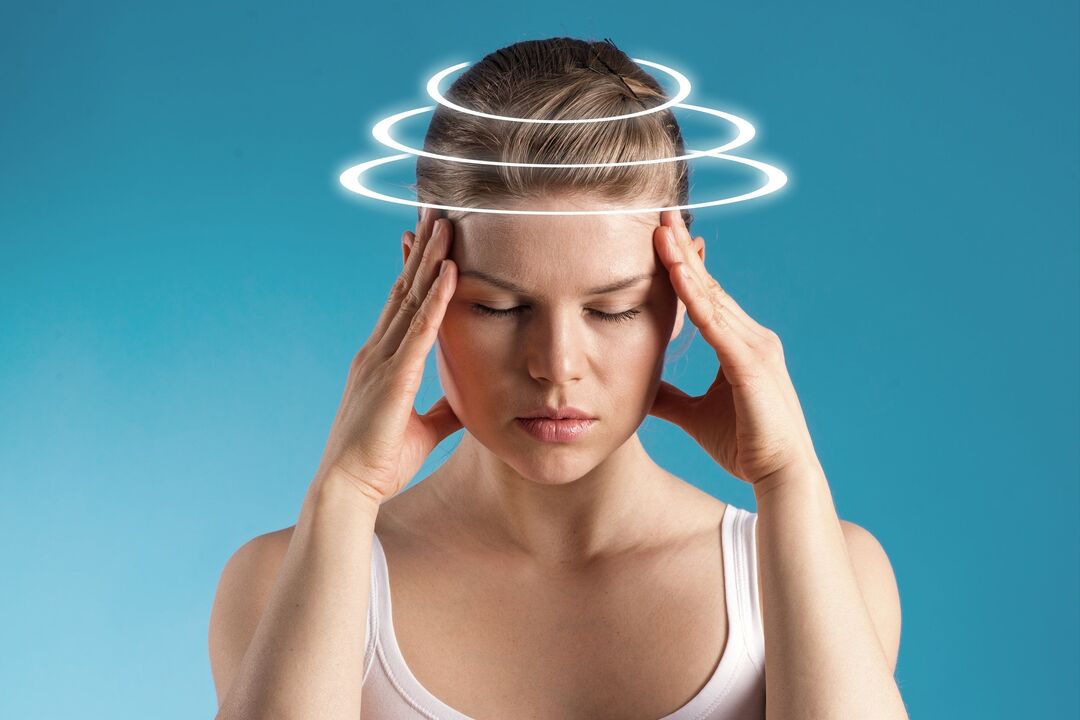
The vertebrae of the cervical spine are quite thin, so when holding the head they are subject to severe stress. They are more susceptible to deformation than the thoracic vertebrae.As a result of the deviation, dizziness occurs, which can be:
- Systemic. There is a feeling of circular movement of the body and surrounding objects. It occurs due to a malfunction of the vestibular apparatus, muscles and receptors in the joints.
- Not system. The patient has a feeling of lightheadedness, stupor and uncertainty in an upright position. There is no sensation of circular rotation.
If such a symptom occurs, you should immediately consult a doctor. Reasons for emergency hospitalization of the patient:
- numbness in part of the shoulder;
- paralysis of facial muscles;
- loss of consciousness;
- Strong headache.
Displaced vertebrae and muscle spasms lead to pinched nerves that supply the brain. Due to lack of oxygen, dizziness occurs. InitiallyOxygen deficiency occurs in the back of the head, as this is the center of the vestibular apparatus.
Lack of air
Lack of air during osteochondrosis can be of several types: breathing problems and lack of oxygen. Breathing becomes difficult due to pinched nerves that transmit signals from the pharynx to the esophagus.
When the vertebrae are displaced, patients experience shortness of breath. This condition often occurs during stressful situations. After their completion, normal breathing is restored. Sometimes there is a lump in the throat that cannot be washed down or swallowed.
Lack of air occurs due to a pinched nerve. As a result, a spasm of the diaphragm occurs, which is fraught with changes in the depth and rhythm of breathing. The patient becomes stuffy and has difficulty breathing. This is a serious symptom, since shortness of breath with osteochondrosis is dangerous for the development of a number of other complications. In this case, the doctor prescribes medication.
Nausea
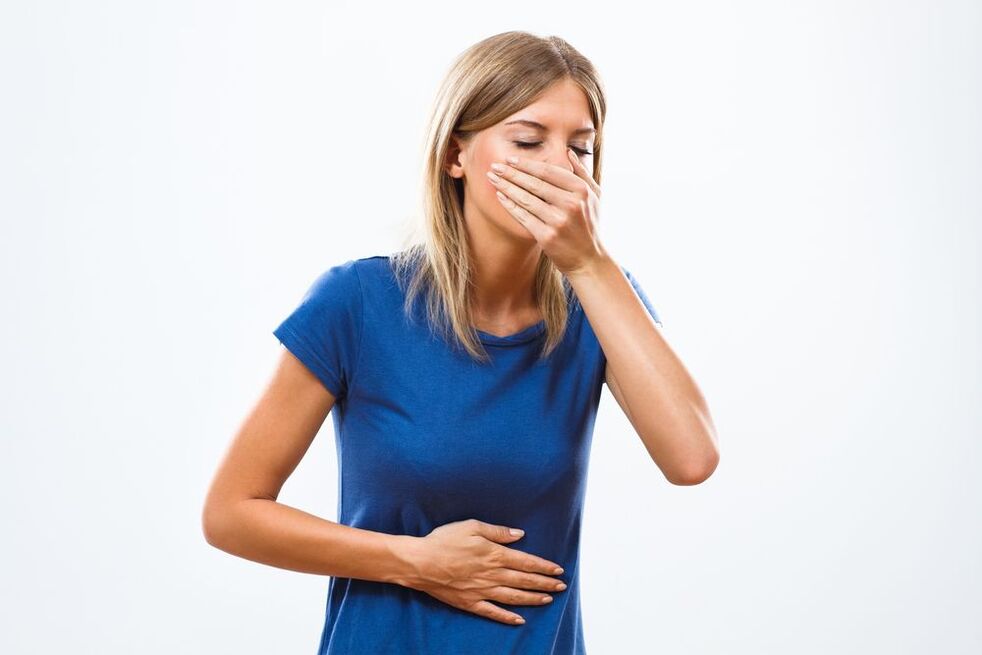
An insufficient amount of arterial blood flows to the posterior structures of the brain. This triggers a compensatory reaction mechanism.Narrowing of the arteries leads to increased blood pressure. The patient experiences a feeling of nausea.
If blood flow to the posterior structures of the brain is not restored, the patient will experience vomiting and loss of consciousness. Long-term impairment of cerebral circulation is fraught with the development of stroke and further disability.
Vision problems
With osteochondrosis of the neck, the patient may experience double vision, floaters and flickering. They indicate the onset of serious diseases that appear against the background of osteochondrosis. These include the following diseases:
- glaucoma;
- cataract;
- Claude Bernard-Horner disease.
Glaucomaaccompanied by increased intraocular pressure and damage to the optic nerve. Treatment will only help achieve remission, but not eliminate the pathology completely.
Cataractsuggests destruction of the lens. This occurs due to a malfunction in the metabolic processes of the brain. The first symptom of such a disease is spots before the eyes. If treatment is not started promptly, the patient may completely lose vision.
Claude Bernard-Horner disease. The cause of the development of the disease is hypoxia of the occipital region and damage to the optic nerve. Symptoms of the disease are worsening pupil reaction and a difference in their size. Sometimes the patient cannot close his eyelids completely. Serious problems with twilight vision are observed.
Blood pressure surges
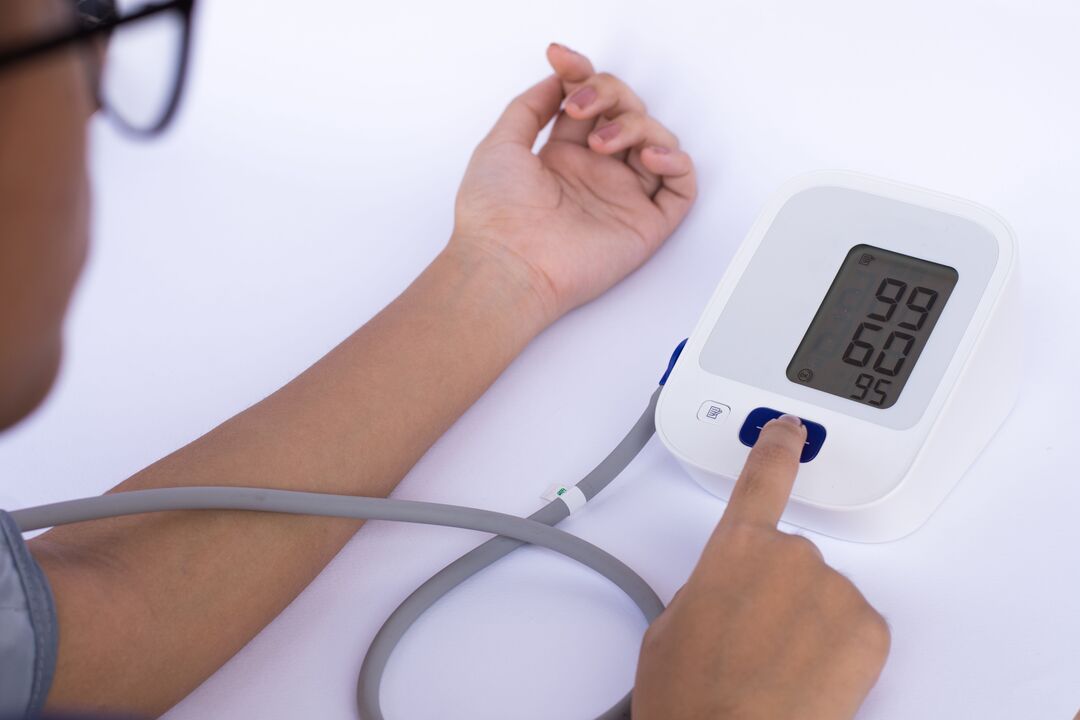
Jumps are observed throughout the day. This disease is not characterized by long-term hypertension. The spasmodic daily dynamics of arterial hypertension occurs due to reflex irritations of nerve endings and short-term spasms of blood vessels.
Symptoms of increased blood pressure with cervical osteochondrosis:
- headache;
- pressure surges after stress or muscle strain;
- pain in the limbs;
- low sensitivity in the collar area.
If there are sudden jumps in blood pressure and a significant deterioration in your general condition, you should seek emergency help.
Sudden fainting or syncope
Sudden fainting can occur as a result of a short-term cessation of blood flow through the vertebral arteries. If the patient has lost consciousness, he must be placed so that his legs are higher than his head. This activates blood flow to the brain. After fainting, problems with speech and movement may occur.
Pharyngeal problems
Sometimes only pharyngeal symptoms may indicate the occurrence of degenerative processes in the cervical vertebrae. They manifest themselves through:
Such signs are associated with injury to the neurovascular trunks that come from the spinal cord. However, these symptoms are observed not only with osteochondrosis, but also with inflammation and tumors.
Increase in body temperature
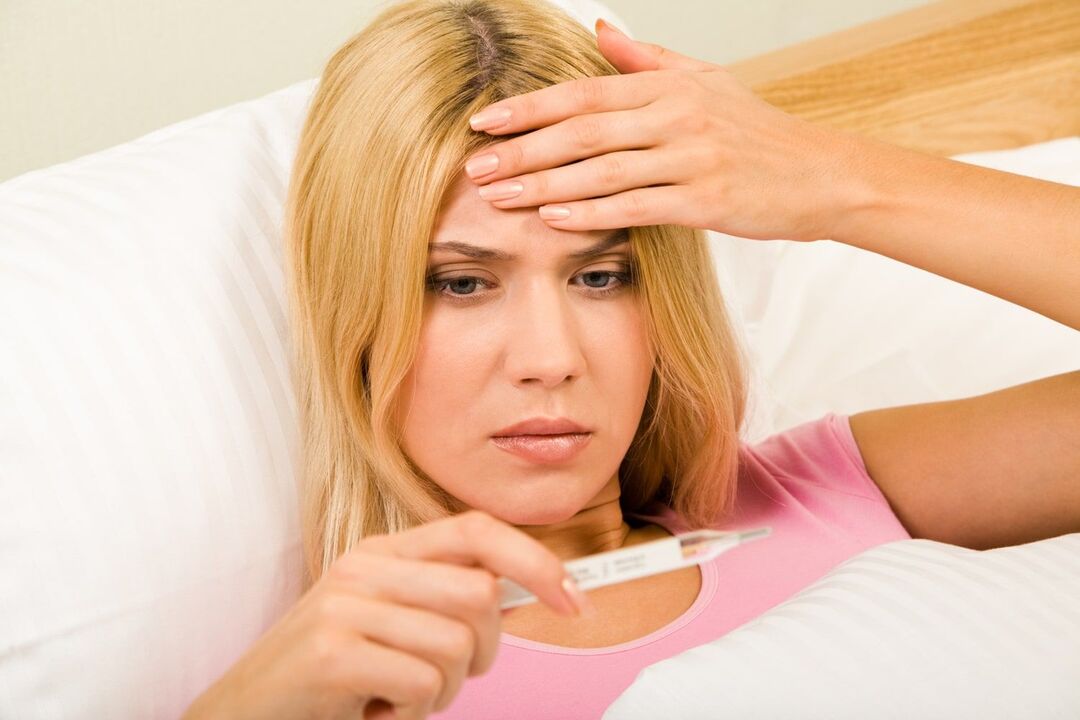
With cervical osteochondrosis, body temperature rises. This symptom occurs with the following lesions:
- vertebral artery syndrome;
- disc protrusion;
- spinal canal stenosis.
Elevated body temperature can be triggered by neurosis, neurological vomiting and fibromyalgia syndrome. Sometimes several pathological conditions are observed at once, which aggravate the symptoms of osteochondrosis.
Manifestations depending on the stage of the disease
- At the first stage of the disease, symptoms may not be observed. The first signs of the onset of degenerative processes: headache; mild limitation of neck movement; discomfort in the neck and arms.
- In the second stage of development, protrusion of the vertebral discs begins, and the brain fissures begin to narrow. The pain becomes more pronounced, ringing in the ears and sleep disturbances appear.
- The third stage is characterized by the destruction of the fibrous ring in the disc. Dislocations and displacements of the vertebrae, hernias in the cervical spine occur.
- At the fourth stage, most degenerative changes are irreversible.
Which ones arise in the brain?
Symptoms in the brain may be severe or minimal. Cerebral deviations occur only when the vertebral artery is strongly compressed by bony outgrowths. As a result, problems arise with blood access to the brain, and this provokes spasms of small vessels and disruption of the hypothalamus.
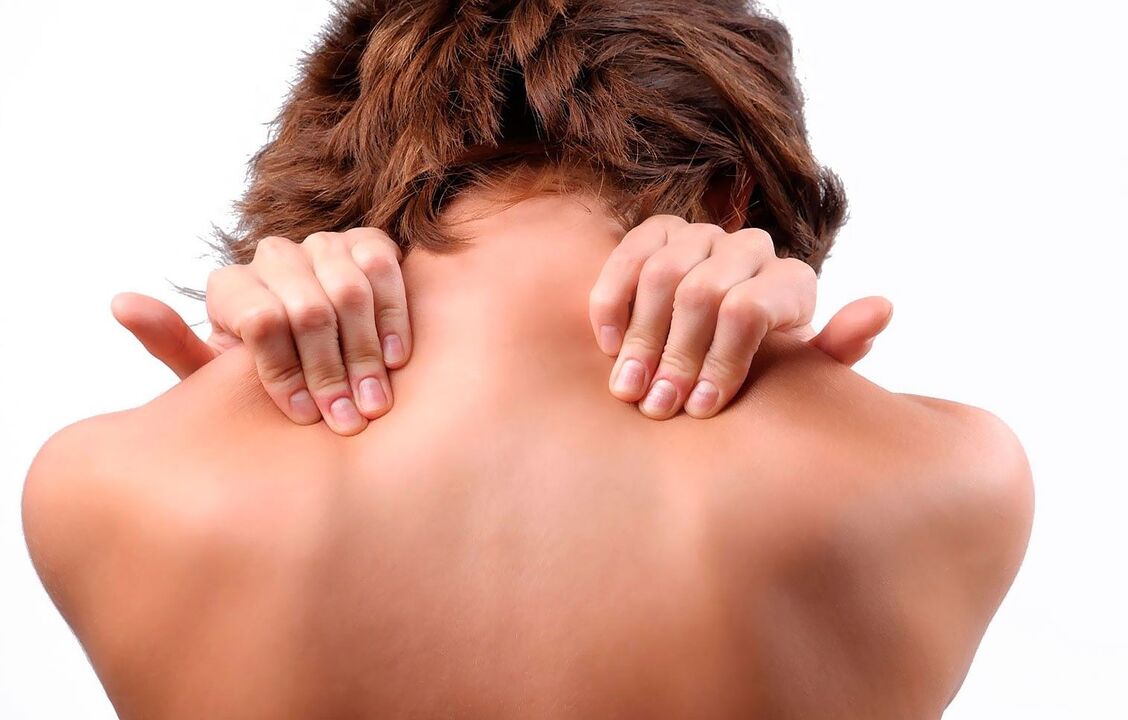
With cervical osteochondrosis, the following syndromes may occur::
- Hypothalamic. It can be neurological and physical.
- Syncope and drop syndrome. They appear in the fact that the patient feels weakness in the legs and loses consciousness for several minutes.
- Vestibular-stem. Dizziness occurs when turning the head.
As a result of such degenerative processes, the patient tries to avoid public places. At the same time, he develops unreasonable fears and depression.
Differences between women and men
The symptoms of cervical chondrosis in men and women are practically no different. Degenerative changes in the cervical vertebrae are more common in women, this is explained by the anatomical structure of the cervical spine. In men, the neck muscles are better developed.
Pregnancy has a negative impact on the condition of the spine. In most cases, standard symptoms are observed. In men it may be more pronounced.
Spinal chondrosis in children and adolescents
Spinal chondrosis in children and adolescents occurs due to a general delay in the development of connective tissue. This may be the result of a genetic abnormality or a mineral metabolism disorder. Underdeveloped intervertebral discs are vulnerable to various pathological processes.
The disease occurs due to a sedentary lifestyle, prolonged sitting at the computer and excess weight. The symptoms of this disease are similar to the manifestations of osteochondrosis in adults. When the cervical spine is affected, the patient experiences neck pain, attacks of dizziness and migraines.
Diagnostics
Before making a diagnosis and prescribing treatment, the doctor conducts a series of diagnostic examinations.An external examination is carried out, posture is assessed and muscle condition is studied..
CT scan
Computed tomography makes it possible to see bone tissue in a 3D projection. In principle, this procedure is similar to an x-ray. However, such diagnostics allows you to see a layer-by-layer image.
This procedure is not performed on children and pregnant women, as there is a high dose of X-ray radiation. Contraindications include the patient's inability to remain still for several minutes.
X-ray
X-ray is a classic procedure that is prescribed to diagnose osteochondrosis.. It is practically harmless and allows you to assess the degree of degenerative changes. Using this technique, it is possible to identify the disease in the early stages.
An examination is prescribed if there is a suspicion of damage to the cervical spine. The clear advantage of this method is its low cost. This procedure will take 15-20 minutes.
X-ray does not make it possible to obtain layer-by-layer images of the affected tissues. There are a number of more modern and informative examination methods. X-ray is only suitable for initial diagnosis.
Osteochondrosis is a dangerous disease that, without timely treatment, can lead to irreversible degenerative changes and disability. At the initial stage, only mild discomfort may be present. As the pathological process develops, the symptoms become more intense. When the first signs of spinal damage appear, you should immediately consult a doctor.
Osteochondrosis of the cervical spine - symptoms and treatment
Neck problems are quite difficult for people to tolerate. After all, these are difficulties with turning the head, the inability to bend over, and other troubles that seriously reduce a person’s quality of life.
When a person begins to have difficulties in the cervical spine, they speak of the onset of osteochondrosis. Cervical osteochondrosis is a degenerative disease that affects the intervertebral discs in the neck. The most commonly affected vertebrae are C5, C6, C7.
Today, osteochondrosis of the neck has become seriously younger and can increasingly be observed in people from 30 to 50 years old, i. e. the most able-bodied population. Moreover, many do not even suspect that they have such a pathology.
After all, painful sensations appear infrequently and little. Here it is worth understanding that timely treatment will allow you to cope with the problem and quickly return the person’s joy of life and performance.
How to recognize this disease
A person should definitely listen to himself in order to recognize in time the beginning processes of destruction in his body. This will allow you to start therapy faster.
In total, with osteochondrosis the following symptoms and signs will be observed:
- According to pain: pain is localized in the neck, in the back of the head, in the shoulders, arms and even legs; if nerve endings are connected to the pathological process, then the person will feel discomfort in the shoulder area, pain will appear in the occipital part, and restructuring of the arms will be noticeable
- On the part of the hands: their restructuring occurs against the background of a decrease in sensitivity in the hands, damage to the root with the nerves responsible for sensitivity; the root that includes the motor nerves is compressed
- From the side of the head: crunching when turning and bending, pain, etc.
- From the general condition: feeling of persistent fatigue, frequent dizziness, problems with coordination, vision problems, loss of sensitivity of the tongue
The symptoms of cervical osteochondrosis in women are exactly the same as in men. In addition, women aged 45-60 years old may experience numbness in their hands during sleep, as well as a tingling feeling in them.
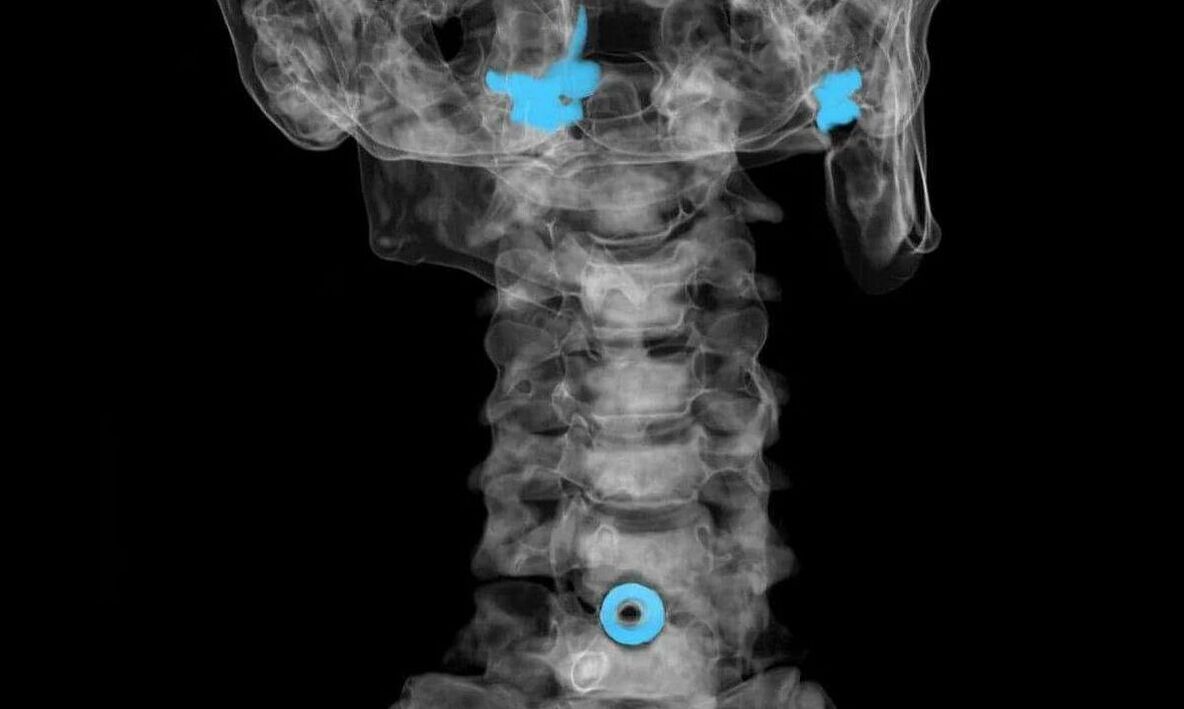
- Examination by a doctor and medical history
- Taking an X-ray: this method will allow you to determine changes in the mobility and location of the vertebrae, provide a study of the reduction of intervertebral gaps and make it possible to see salt deposits
- Carrying out a CT scan: this research method is considered one of the most accurate; with its help you can see ruptures, various changes that the disc has undergone, assess the instability of the vertebrae, what is the compression of the nerve fibers and brain of the back
- MRI: this diagnostic method helps to see all pathological changes, allows you to determine blood flow and the condition of the nerve roots
It is believed that examination and x-ray data are sufficient to make an accurate diagnosis. The remaining options are used only in cases where the situation is not clear and there is room for doubt..
What should be the treatment?
Therapy for osteochondrosis of the cervical spine should be complete and comprehensive. This is the only way to achieve an ideal result and stop the destruction process. Here it is worth understanding that both the doctor and the patient will have to work.
First aid for exacerbations
The acute phase of the disease occurs, as always, accidentally and unexpectedly. And it’s worth learning first aid methods so that you can at least get to the doctor. Typically, the main recommendation is to apply a pepper patch to the affected area. This measure will relieve pain. But the effect will be short-lived.
If swelling has developed, you can try herbal decoctions - they should be consumed for at least 3-4 days, then the effect will be noticeable.
After relieving acute pain, you should immediately go to the doctor. He will study the patient’s condition, draw conclusions about the destructiveness of the situation and select adequate therapy.
When diagnosing osteochondrosis of the neck, they immediately offer a whole list of drugs with different spectrum of action. All of them make it possible to generally normalize a person’s condition and restore his joy of life. The list includes:
- Non-steroidal anti-inflammatory drugs - such drugs are recommended to be used for 1-2 weeks, 2-3 times a day. Typically, to reduce their destructive effects on the body, such products are recommended to be used after meals.
- Muscle relaxants: such drugs provide better muscle tone and relieve spasms
- Diuretics: with the help of these options you can get rid of swelling in the damaged area
- Corticosteroids: drugs that reduce pain, they are especially effective for severe pain, ideally they should be prescribed with analgesics
- Blockades are made on the basis of novocaine and lidocaine: usually this is professional therapy, i. e. performed by doctors; During the procedure, they inject the drug subcutaneously or intramuscularly into several points near the affected vertebrae
- Chondroprotectors: drugs that ensure the restoration of cartilage tissue
- B vitamins - such drugs are responsible for improving metabolic processes in nervous tissue, providing higher neuromuscular conductivity
It happens that local therapy is prescribed in combination with medications. Usually we are talking about warming ointments, such as Fastum gel, Finalgon, etc.
Physiotherapy and exercise therapy
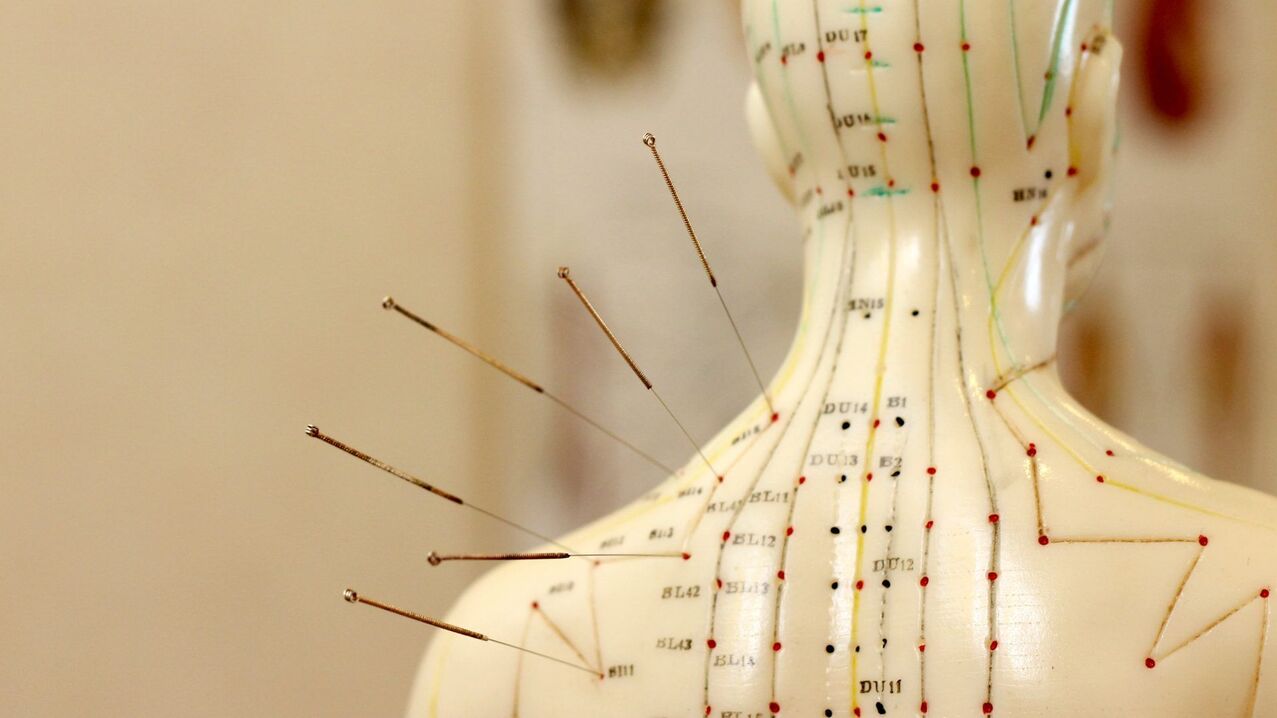
- Treatment with special currents called modulated
- Reflexology
- Orthopedic gymnastics
- Using special exercise equipment for physical activity
- Massages
- Electrophoresis - in this case, active medicinal substances are introduced into the skin using electrodes
- Magnetotherapy
- Ultrasound
- Laser
All these techniques help relieve muscle spasms, improve a person’s condition, and have a beneficial effect on his nervous system..
As for exercise therapy, it should not be neglected. After all, moderate and thoughtful physical activity will tone the muscles and ensure a person’s normal well-being. Immediately after the period of exacerbation, you can begin exercises, especially since they are quite simple and accessible to everyone.
List of exercise optionswill be suggested to the patient by his attending physician. He will draw it up based on the complexity of the situation and the need for certain loads. Among the standard options they offer:
- Lie with your stomach down, support yourself with your hands. Raise your head and body slightly, but keep your back straight and do not fall through. You need to hold yourself in this position for a couple of minutes, then return to the starting position. There should be 2-3 repetitions
- Lie on the floor, stretch your arms along your body, try to touch your ear to the floor, then turn your head for the same purpose. Repeat 6-7 times
- Sitting on the floor, inhale and tilt your head to your chest, reaching with your chin, exhale and send your head back all the way. There should be 10-15 repetitions of this exercise.
It should be remembered that there should be no pain during the exercises. If they appear, you should stop doing gymnastics and consult your doctor.
Home therapy methods

Folk remedies are often used for medicinal purposes. Recommendations of this kind have been tested over the years. So, for example, you can useointment with hops. It’s not difficult to prepare: you need to grind a tablespoon of pine cone powder with 1 tbsp. butterThe sore spot should be rubbed with this product and wrapped well. If the ointment is used regularly, both inflammation and pain will go away.
Rubbing is a great way. To carry them out, it is enough to prepare a special infusion. Half a glass of elderberry and a couple of glasses of alcohol should be infused for 7 days, putting everything in a dark place. Then all that remains is to rub the infusion into the affected area.
You can make a compress literally from what you have on hand. An excellent solution would bea mixture of honey and grated potatoes.
Fresh and peeled potatoes should be grated and mixed with honey. This entire mass should be wrapped in gauze and placed on the neck area for 20 minutes.
The body position should be kept motionless. It is enough to carry out this procedure once a week.
Traditional medicine should be practiced only with the permission of the attending physician. After all, there is a real risk of making things worse for yourself, and this cannot be allowed.Therefore, it is important to discuss all methods with the treating specialist so that you can react in time if something goes wrong.
Surgical intervention
It is worth preparing for the possibility that surgical intervention is possible.
Surgery is used if inflammation in the vertebrae has reached stages 3-4 of its development, conservative methods do not work, and the person’s condition is rapidly deteriorating.
The operation is one of the least traumatic. A small incision is made in the neck, and then using a special microscope and microneurosurgical instruments, the destroyed disc is removed, replacing it with an implant. Titanium plates are sometimes used to strengthen the spine in the affected area.
The duration of the operation is usually not too long - a couple of hours. The patient may feel better the very next day, and on the 5th day he is usually discharged. After this intervention, the pain goes away almost immediately.
Preventive measures against cervical osteochondrosis

To prevent unpleasant consequences and painful sensations, you should follow simple rules. Among them:
- Playing sports - swimming can have a particularly good effect, it gives an even load, while unloading the body itself, so you don’t even feel pain when moving
- Reviewing the diet and including more products with magnesium and calcium (fish and other seafood), beans, peas, seeds, milk and other products made from it, cheeses, spinach, etc. You will have to exclude hot peppers, pickles, grapes, flour products, sugar, smoked meats and other potentially harmful products.
- Performing exercises right in the office while working sedentary
- For sleeping, you should choose a comfortable mattress and pillows
Such recommendations are within the power of everyone, but at the same time they can easily protect against the development of osteochondrosis at any age. In addition, they are accessible to everyone and will not pose a problem for their implementation.
Osteochondrosis of the cervical spine always takes you by surprise. But you shouldn’t get upset right away; you need to take all available measures that will normalize the situation and regain your health.



















